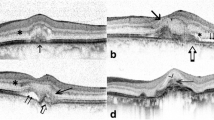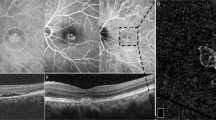Abstract
To report the changes seen in the photoreceptor layer during the acute phase of sympathetic ophthalmia. Six consecutive patients diagnosed with sympathetic ophthalmia were enrolled in the study. All 6 patients had a fundus fluorescein angiogram and spectral domain optical coherence tomography (OCT) scan carried out at presentation. The outer retinal segment was demarcated on the raster line scan between the external limiting membrane (ELM) and the retinal pigment epithelium (RPE)–choriocapillaris complex. All patients received intravenous methylprednisolone followed by oral corticosteroids 1–1.5 mg/kg/day. The serial follow-up OCT scans taken 48 h after the initiation of treatment, and 1, 2 and 12 weeks later, were studied and compared. The retina inner to the ELM did not show any remarkable structural alteration in any of the eyes. The outer retinal segment demarcated by the ELM and the RPE–choriocapillaris complex showed serous retinal detachment in all the eyes and elongation of photoreceptors could be seen in four eyes. There was a disruption to the continuity of the two inner hyper-reflective bands in all the eyes. A repeat raster line scan performed 48 h after systemic corticosteroid therapy showed a reduction in the height of the serous retinal detachment with elongation of photoreceptors and the protrusion of their apical segments into the serous detachment in 4 eyes. The serous detachment showed a progressive reduction in height following intravenous methyprednisolone therapy in all the eyes over the following week with elongated photoreceptors in all six eyes. After two weeks, none of the eyes showed any residual detachment and this corresponded with the improvement in visual acuity in all the eyes. OCT raster line scans repeated at 4 weeks showed resolution of serous detachment with normal photoreceptor layer and restoration of a third hyper-reflective band (IS/OS junction) in all the eyes. The photoreceptor layer is involved during the acute phase of sympathetic ophthalmia as indicated by the in vivo morphological changes seen on spectral domain OCT. These changes are reversible following systemic corticosteroid therapy thus supporting the hypothesis that prompt and aggressive anti-inflammatory therapy is capable of reversing the photoreceptor changes.







Similar content being viewed by others
References
Damico FM, Kiss S, Young LH (2005) Sympathetic ophthalmia. Semin Ophthalmol 20:191–197
Gupta V, Gupta A, Dogra MR (2008) Posterior sympathetic ophthalmia: a single center long-term study of 40 patients from North India. Eye 22(12):1459–1464
Apple DJ, Rabb MF (eds) (1998) Ocular pathology: clinical applications and self-assessment, chap 8. Mosby-Year Book Inc, St. Louis, pp 416–417
Lubin JR, Albert DM, Weinstein M (1980) Sixty-five years of sympathetic ophthalmia. A clinicopathologic review of 105 cases. Ophthalmology 87:109–121
Parikh JG, Saraswati S, Rao NA (2008) Photoreceptor oxidative damage in sympathetic ophthalmia. Am J Ophthalmol 146:866–875
Sharp DC, Bell RA, Patterson E, Pinkerton H (1984) Sympathetic ophthalmia. Histopathologic and fluorescein angiographic correlation. Arch Ophthalmol 102:232–235
Easom HA, Zimmerman LE (1964) Sympathetic ophthalmia and bilateral phacoanaphylaxis: a clinicopathologic correlation of the sympathogenic and sympathizing eyes. Arch Ophthalmol 72:9–15
Woods AC (1936) Sympathetic ophthalmia. Am J Ophthalmol 19:9–15
McPherson SD Jr, Dalton HT (1975) Posterior form sympathetic ophthalmia. Trans Am Ophthalmol Soc 73:251–263
Chang CW, Hinz BJ, Macdonald EA, Baker CF, Greve MD (2006) Bilateral exudative retinal detachments as initial presentation of sympathetic ophthalmia in Turner Syndrome. Can J Ophthalmol 41:494–496
Muller-Hermelink HK, Kraus-Mackie E, Daus W (1984) Early stage of human sympathetic ophthalmia. Histologic and immunopathologic findings. Arch Ophthalmol 102:1353–1357
Croxatto JO, Rao NA, McLean IW et al (1981) Atypical histopathologic features in sympathetic ophthalmia: a study of a hundred cases. Int Ophthalmol 3:129–135
Galor A, Davis JL, Flynn HW et al (2009) Sympathetic Ophthalmia: Incidence of ocular complications and vision loss in the sympathizing eye. Am J Ophthalmol 148:704–710
Author information
Authors and Affiliations
Corresponding author
Rights and permissions
About this article
Cite this article
Gupta, V., Gupta, A., Dogra, M.R. et al. Reversible retinal changes in the acute stage of sympathetic ophthalmia seen on spectral domain optical coherence tomography. Int Ophthalmol 31, 105–110 (2011). https://doi.org/10.1007/s10792-011-9432-1
Received:
Accepted:
Published:
Issue Date:
DOI: https://doi.org/10.1007/s10792-011-9432-1




